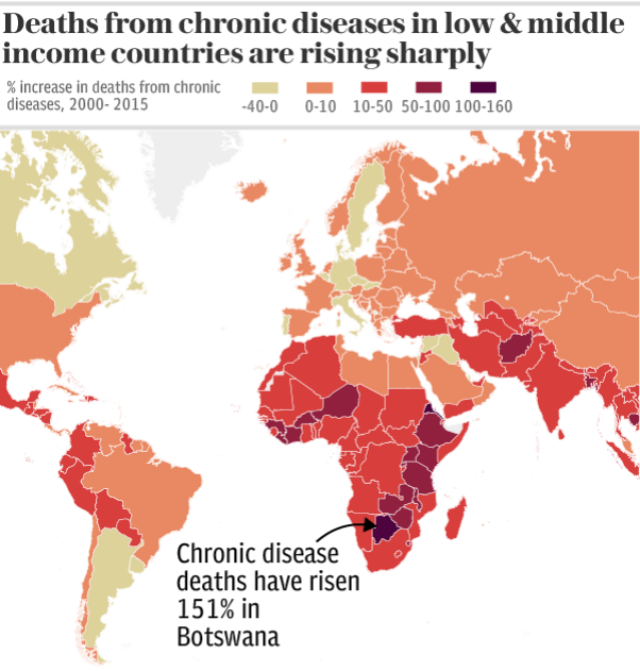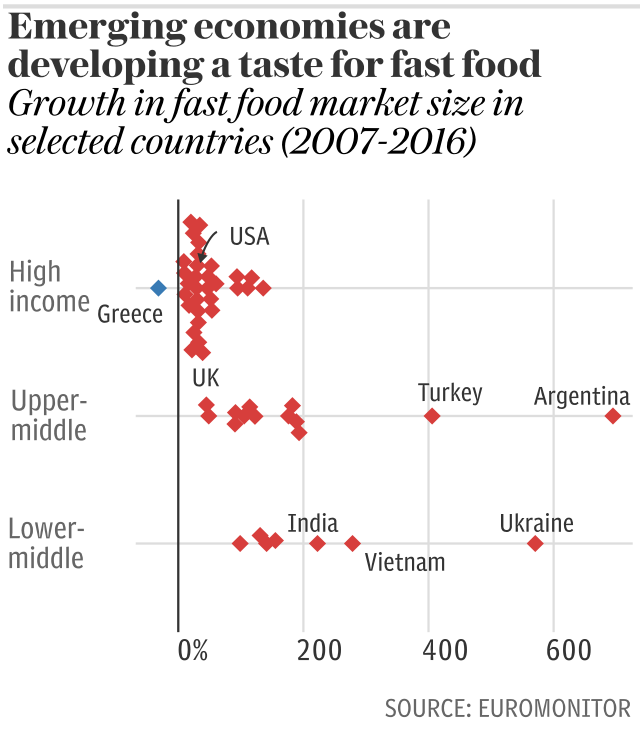Mapped: the global epidemic of 'lifestyle' disease in charts

Non-communicable diseases (NCDs) such as heart disease, cancer and diabetes now account for 90 per cent of deaths each year in the UK.
These so-called 'lifestyle' conditions are a well known problem in the west. Much less understood is that they now account for the majority (53 per cent) of deaths and disabilities in the developing world – taking 31 million lives a year.
NCDs are not driven by infections and viruses but by behaviours such as poor diet, smoking, moving too little, alcohol and drugs.
Although often referred to as lifestyle issues – implying personal choice – the rapid spread of NCDs around the world suggests they are a more universal problem, correlating strongly with economic development and urbanisation.
Globally, 70 per cent of deaths – some 40 million – are now attributed to non-communicable diseases (NCDs), with lower and middle income countries becoming increasingly impacted as there economies grow.

“Many of these countries are going through significant demographic shifts, including rapid urbanisation and a nutrition transition,” said Katie Dain, chief executive of the NCD Alliance.
Dain added that NCDs were killing more people earlier in developing counties than in the developed world – over 80 per cent of the 15 million NCD deaths that take place between age 30-69 are in low and middle income countries
“This is having a more severe impact on people’s lives and national economies,” said Ms Dain. “It’s during these years that people are meant to be at their most productive, earning a living – bringing money home to their families and contributing to economic growth.”

In all regions of the world with the notable exception of Africa, more people are dying today from NCDs than from any other cause.
Although more people in Africa continue to die from infectious and viral conditions such as HIV/AIDS and malaria, deaths from chronic conditions are rising rapidly, up by 42 per cent since 2000 across the continent.
The World Health Organization predicts NCDs will be the biggest killers in Africa by 2030.
The risk factors for chronic diseases include smoking, physical inactivity, high levels of alcohol consumption and obesity.

Although tobacco remains the leading cause of chronic conditions, smoking rates on the whole are falling – except in the Middle East and sub-Saharan Africa.
Obesity rates have however, rocketed worldwide in the last four decades.

Johanna Ralston, chief executive of the World Obesity Federation, says that obesity is both a key risk factor for NCDs as well as a disease in itself.
“Obesity leads to cardiovascular problems and diabetes and even many cancers. It’s both an entry point for what progresses into other diseases and is a disease state itself,” she said. “Today obesity is recognised as a driver for NCDs in the way tobacco was around fifteen years ago”.
While rates of obesity have risen in every country of the world since 1975, the obesity epidemic has hit hardest in the Middle East and the Pacific nations where high levels of imported foods have contributed to expanding waistlines.
The Gulf’s rapid economic growth, leading to a change in diet, and hot climate, which discourages people from exercising outside, have also helped fuel the region’s obesity epidemic, says Ms Ralston.
Kuwait, Jordan, Egypt and Qatar are seeing levels of obesity comparable to the USA, with diabetes and other weight-related conditions becoming a major public health concern.

More surprising perhaps, obesity is also rising in countries that only a few decades ago were experiencing food shortages. In Ghana, for example, obesity has soared by over 600 per cent since 1975 and now affects one in 11 adults.
There is now a clear understanding of the relationship between NCDs and poverty in many places, said Ms Dain.
“NCDs are a cause and consequence of poverty,” she said. “It’s often the poorest that are most vulnerable to NCDs and in many countries you are seeing NCDs impacting on lower socio-economic proportions of populations.”
Big tobacco, big food, big alcohol
While the causes of chronic diseases in low and middle income countries are complex, experts and campaigners are increasingly pointing the finger at big business and the so-called "commercial determinants of health".
“It’s very clear that big tobacco, big food and big alcohol are seeing many lower and middle income countries as their emerging target markets," said Ms Dain. She said that many tobacco companies in particular increasingly see Africa –which currently has a low level of female smokers – as a potential opportunity.
The spotlight has recently also fallen on the fast food and sugary drinks industries.
Last year a study on global obesity by Imperial College London and the WHO found a 10-fold increase of the condition among children which the study’s authors attributed to the impact of food marketing and food policies.
While fast food chains still continue to see growth in many traditional markets such as the US and the UK, the most spectacular growth is taking place in emerging economies.

Fast food spending grew more in the United Arab Emirates from 2010-2015 than in any other country. The country has also seen a rapid rise in non-communicable conditions.
Most foods we eat here have a high calorie content and high carbohydrate content. That’s the food that’s affordable and tastes good
Dr. Abdul Razzak AlMadani, Dubai's Al Borj Medical Centre
Abdul Razzak AlMadani, a consultant in medicine and endocrinology at Al Borj Medical Centre in Dubai and President of the Emirates Diabetes Society puts the rise down to among other things changing lifestyles and eating habits in the past few decades.
“It’s fast food, but not only fast food,” said Dr AlMadani. “Most foods we eat here have a high calorie content and high carbohydrate content. That’s the food that’s affordable and tastes good.”
Dr AlMadani believes that raising awareness of the risks of diabetes and hypertension among the population – particularly among parents who he says pass on unhealthy eating habits to their children – is one key way to bring down the incidence of these conditions.
Junk food taxes are working
Alongside awareness, a number of countries have also started to fight back against the marketing and consumption of unhealthy foods with tax on harmful foods and drinks.
This replicates the strategy developed countries have taken in tackling tobacco and alcohol consumption.
For Rebecca Perl, director of partnerships and initiatives at US-based non-governmental organisation, Vital Strategies, taxes can go a long way to reducing consumption of unhealthy food and drinks.
“Taxes are a win-win,” said Ms Perl. “They help people reduce use of unhealthy products but also bring money to governments to put health policies in place.”
Mexico, where more than 70 per cent of the population is overweight or obese, is already reaping benefits from such a levy. In 2014, the country introduced a tax of 1 peso (4 pence) per litre of sugary drink.

Although it is too early to say what impact this will have, early results are promising.
A study of the tax by researchers in Mexico and the United States found that sugary drinks purchases fell by an average of 7.6 per cent in the two years after the tax was introduced.
The UK is also set to introduce a sugary drinks tax in April.
Ms Dain believes that the UK has many good lessons to share at this September’s UN high-level summit on NCDs that can be a model for other countries battling NCDs.
“There have been many commitments and targets but implementation in low and middle income countries, where there are many competing urgent priorities, has been slow,” said Ms Dain. “The UK has lots of good practices and examples such as plain packaging on cigarettes or tackling childhood obesity by taxing sugary drinks".
Protect yourself and your family by learning more about Global Health Security

 Yahoo News
Yahoo News 
